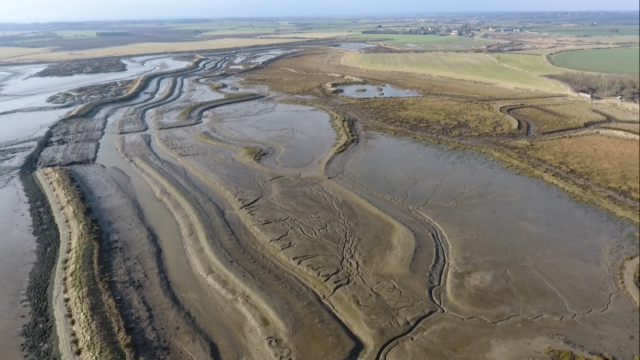Across Essex’s 350-mile-long coastline, saltmarshes are a distinctive feature. Along the Blackwater Estuary, saltmarsh is over 35,000 years old. However, the UK is losing 100 hectares of saltmarsh per year. In many cases, rising sea levels and man-made sea walls have forced this habitat to recede.
It has been twenty years since Essex Wildlife Trust set out to recover saltmarsh and create an international case study for future conservation at the Trust’s headquarters, Abbotts Hall nature reserve.
Managed realignment involves the removal or re-positioning of man-made sea defences, such as sea walls, to create new habitat that benefits both wildlife and humans.
In October 2002, Essex Wildlife Trust, alongside key partners, breached the weathered sea wall that lined over 3,500 metres of the Blackwater Estuary. At the time, over 1,000 members of public, staff, politicians and conservationists were present to witness the creation of a new intertidal habitat spanning 50 hectares.
Intertidal habitats like saltmarsh support a variety of wildlife, including marsh samphire, sea lavender, shore crabs, shrimps and other small insects. Birds like marsh harriers, peregrine falcons and merlin also benefit from this new feeding ground.
Since the managed realignment took place, the Trust’s surveys have revealed over 14 species of fish utilising the saltmarsh, including European eel, thin-lipped grey mullet and common goby.
Saltmarsh is a significant contributor to fighting climate change. One hectare of saltmarsh can capture four tonnes of carbon per year. Carbon is captured by plants within the saltmarsh and can be stored there for centuries.
By creating additional saltmarsh, neighbouring coastal communities are also benefitting from a natural coastal buffer. Saltmarsh can absorb the impact of coastal pressures such as storm surges and flooding.
Mark Iley, Head of Landscape and Rivers Recovery at Essex Wildlife Trust, was present at the time of the breach:
“Twenty years ago, we watched the tide flooding in and welcomed the return of the intertidal habitat. As a new member of staff, I couldn’t believe my fortune to have landed a role in an organisation undertaking the biggest managed realignment in Europe at the time.”
Rachel Langley, Head of Marine and Coastal Recovery for Essex Wildlife Trust, adds:
“We must do all we can to recover and protect saltmarsh. Not only does it support an abundance of wildlife, but it helps protect us against the changing climate and coastal pressures. The managed realignment site at Abbotts Hall is consistently monitored for signs of life, and as a force for good against climate change. We hope that this case study inspires other managed realignments, and further protection of saltmarshes.”




